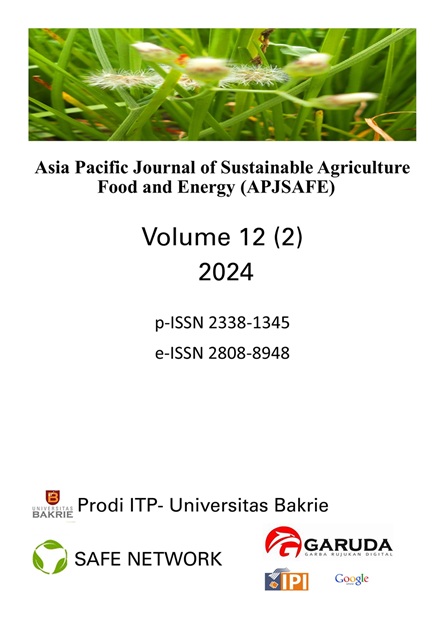Impact of Okara Tempe powder concentration and particle size on color and sensory properties of cookies
DOI:
https://doi.org/10.36782/apjsafe.v12i2.192Keywords:
cookies, okara, tempe gembus, particle size, sensoryAbstract
Okara, a byproduct of soymilk production, is traditionally fermented into tempe and is rich in fiber, making it a cost-effective food ingredient. This study evaluates the color and sensory properties of cookies formulated with okara tempe powder (OTP) of varying particle sizes and concentrations. Results indicated that higher OTP concentrations and coarser particle sizes led to darker cookies, with significant changes in redness/greenness (a*), and yellowness/blueness (b*) values. Sensory attributes were evaluated using a hedonic scale, revealing that cookies with higher OTP concentrations received lower overall liking scores. Cookies with 30% OTP were the least favored, showing a wide range of scores. Conversely, cookies with 10% fine OTP particles were generally preferred, with no significant difference in mean hedonic scores compared to control samples. Principal Component Analysis (PCA) of hedonic data showed strong correlations among overall liking, aroma, texture, and taste, while appearance was distinct. Sensory descriptors highlighted differences in color, flavor, and texture between control and OTP-containing cookies. Control samples were characterized by "sweet" and "milky" flavors and a "smooth" texture, whereas OTP cookies had "nutty" flavors, a "coarse" mouthfeel, and a "crunchy" texture. Some panelists noted a "bitter" flavor and "gritty" sensation in cookies with 30% OTP. These findings suggest that OTP can influence the sensory properties of cookies, with potential applications in food product development.
Downloads
References
Amelly, Lee, J., Jang, H., Kang, D., Kim, I. and Ha, J.H. 2023. Physicochemical properties of Yanggaeng with added tempeh powder. Preventive Nutrition and Food Science, 28(4), p.514.
Asghar, A., Afzaal, M., Saeed, F., Ahmed, A., Ateeq, H., Shah, Y.A., Islam, F., Hussain, M., Akram, N. and Shah, M.A. 2023. Valorization and food applications of okara (soybean residue): A concurrent review. Food Science & Nutrition, 11(7), pp.3631-3640.
Aussanasuwannakul, A., Puntaburt, K. and Pantoa, T. 2024. Enhancing Gluten-Free Crispy Waffles with Soybean Residue (Okara) Flour: Rheological, Nutritional, and Sensory Impacts. Foods, 13(18), p.2951.
Chae, Y. 2022. Color appearance shifts depending on surface roughness, illuminants, and physical colors. Scientific Reports, 12(1), p.1371.
García-Gómez, B., Fernández-Canto, N., Vázquez-Odériz, M.L., Quiroga-García, M., Munoz-Ferreiro, N. and Romero-Rodríguez, M.Á. 2022. Sensory descriptive analysis and hedonic consumer test for Galician type breads. Food Control, 134, p.108765.
Guàrdia, M.D., Aguiar, A.P., Claret, A., Arnau, J. and Guerrero, L. 2010. Sensory characterization of dry-cured ham using free-choice profiling. Food Quality and Preference, 21(1), pp.148-155.
Gupta, S., Lee, J.J. and Chen, W.N. 2018. Analysis of improved nutritional composition of potential functional food (Okara) after probiotic solid-state fermentation. Journal of Agricultural and Food Chemistry, 66(21), pp.5373-5381.
Hu, C.Y., Chiu, M.C., Christianty, R.A. and Chen, Y.C. 2022. Enrichment of Functional Characteristics in the Okara by the Fermentation of Rhizopus azygosporus. Waste and Biomass Valorization, 13(5), pp.2531-2538.
Kamble, D.B. and Rani, S. 2020. Bioactive components, in vitro digestibility, microstructure and application of soybean residue (okara): A review. Legume Science, 2(1), p.e32.
Lee, D.P.S., Gan, A.X. and Kim, J.E. 2020. Incorporation of biovalorised okara in biscuits: Improvements of nutritional, antioxidant, physical, and sensory properties. LWT, 134, p.109902.
Lindbloom, B. 2012. Color difference calculator. Bruce Lindbloom's Web Site. Retrieved December 26, 2024, from http://www.brucelindbloom.com/index.html?Calc.html
Liu, Y., Yi, S., Ye, T., Leng, Y., Hossen, M.A., Sameen, D.E., Dai, J., Li, S. and Qin, W. 2021. Effects of ultrasonic treatment and homogenization on physicochemical properties of okara dietary fibers for 3D printing cookies. Ultrasonics Sonochemistry, 77, p.105693.
Motoki, K., Spence, C. and Velasco, C. 2023. When visual cues influence taste/flavour perception: A systematic review and the critical appraisal of multisensory flavour perception. Food Quality and Preference, p.104996.
Muliterno, M.M., Rodrigues, D., de Lima, F.S., Ida, E.I. and Kurozawa, L.E. 2017. Conversion/degradation of isoflavones and color alterations during the drying of okara. LWT, 75, pp.512-519.
Ostermann-Porcel, M.V., Quiroga-Panelo, N., Rinaldoni, A.N. and Campderrós, M.E. 2017. Incorporation of okara into gluten‐free cookies with high quality and nutritional value. Journal of Food Quality, 2017(1), p.4071585.
Rizal, S., Kustyawati, M.E., Zulfa, D., Rosida, F., Syifani, F.N.A. and Permatahati, A.D.P. 2024. Chemical properties, sensory characteristics, and antibacterial activity to Staphylococcus aureus of tempeh gembus fermented with Mosaccha inocula. Innovative Food Science & Emerging Technologies, 95, p.103742.
Romulo, A. and Surya, R. 2021. Tempe: A traditional fermented food of Indonesia and its health benefits. International Journal of Gastronomy and Food Science, 26, p.100413.
Shi, H., Zhang, M., Wang, W. and Devahastin, S. 2020. Solid-state fermentation with probiotics and mixed yeast on properties of okara. Food Bioscience, 36, p.100610.
Sinambela, E., Afifah, D.N., Wijayanti, H.S. and Dieny, F.F. 2020. Tempeh gembus cookies as an alternative snack for obese adolescent girls. Amerta Nutrition, 5, pp. 265-270.
Sitanggang, A.B., Sinaga, W.S.L., Wie, F., Fernando, F. and Krusong, W. 2019. Enhanced antioxidant activity of okara through solid state fermentation of GRAS fungi. Food Science and Technology, 40, pp.178-186.
Tuly, J.A. and Ma, H. 2024. Bioconversion of food industrial waste okara by microbial fermentation: Scope of omics study and possibility. Trends in Food Science & Technology, p.104391.
Vong, W.C., Hua, X.Y. and Liu, S.Q. 2018. Solid-state fermentation with Rhizopus oligosporus and Yarrowia lipolytica improved nutritional and flavour properties of okara. LWT, 90, pp.316-322.
Wang, Z., Gao, T., He, Z., Zeng, M., Qin, F. and Chen, J. 2022. Reduction of off-flavor volatile compounds in okara by fermentation with four edible fungi. LWT, 155, p.112941.








